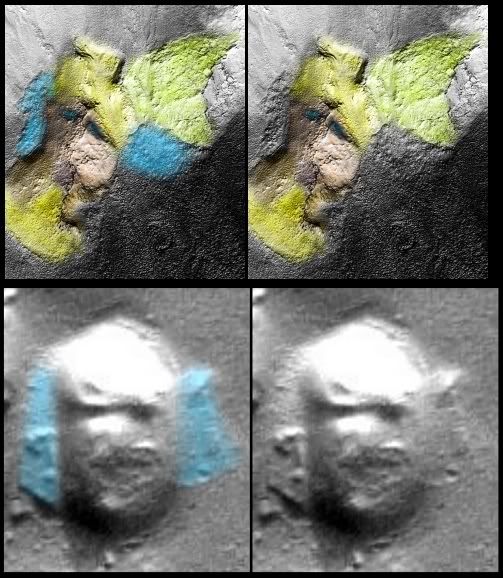|
|
Post by Marsrocks on Aug 11, 2009 13:08:11 GMT -5
I have not seen this one yet, but George's first book was packed with amazing images. He addresses the intellectual side of Mars anomalies better than anyone, and delves into the prolific landscape artwork on the planet as that of an advanced culture - tied closely to the Ancient Mayans/Olmecs of Earth. Very interesting reading!  thecydoniainstitute.com/The-Martian-Codex%3A-More-Reflections-from-Mars.php thecydoniainstitute.com/The-Martian-Codex%3A-More-Reflections-from-Mars.php |
|
|
|
Post by Marsrocks on Aug 18, 2009 15:13:18 GMT -5
|
|
|
|
Post by Marsrocks on Aug 18, 2009 15:36:20 GMT -5
When you consider the portrait image, there are two areas, shown below in blue, that are of a distinctly different texture than the surrounding ground. Those may be a part of the image. If so, could they be sideguards on a helmet. And does that also offer an explanation for what we see on the Utopia face?  |
|
|
|
Post by Marsrocks on Oct 22, 2009 9:07:06 GMT -5
|
|
|
|
Post by Marsrocks on Nov 27, 2009 9:27:50 GMT -5
I got the book Wednesday, and read it yesterday. My crown face birds are mentioned in there - and have a really cool write-up, by the way.
This is the review I just put up on the front page of my website:
"Okay, here's the scoop on "The Martian Codex":
While most of the population of Earth is still stuck on the question of whether or not there were ever any microbes on Mars, George Haas and William Saunders are decades ahead, answering the questions about the human culture that once existed there - what they ate, played, and believed. While Haas and Saunders continue to forge ahead with their examination of the culture, this book provides the non-initiated a unique look at vivid images of some of the most convincing and enlightening finds about the people and the planet.
The authors are politely grateful to the space agencies that brought us the hundreds of thousands of images of Mars, but mark it down in black and white exactly where and when the trusted ones have herded the public away from the water of truth. Where NASA and ESA have exposed their bare haunches, warping, and artistically adding a horn to the "Cydonia Face," pandering "Happy Face Crater" as if it is an accepted bit of evidence of Martian intelligence, manipulating data to produce truly horrible images of the Cydonia Face and the D & M pyramid, ignoring geological evidence, or spreading just plain bad information to the world media, the authors spell it out for the world to see. But knocking NASA and ESA is not the theme of this book, just a necessary detour to lead the sheep out of the dry desert where they were stranded.
The photographs and drawings in this book are of excellent quality. The authors discuss and thoroughly analyze some of the better quality finds, such as the "Crown Face," "the Parrot glyph," the "Maize God," and the "D & M Pyramid." I have to say, it's nice to be able to pull a book from my bookshelf with this set of photos just to show friends who have never considered what was on Mars. But there is much more to this book than photos. At each step of the journey, the authors answer questions about the ancient meso-american cultures (Olmec, Maya) - the artistic styles they used and why, and give insight into why the art on Mars is so complex, and what it means.
For those of us already into Mars anomalies, this book reveals for us the find at Reull Vallis that Keith Laney has been hinting about on his forum for months. This little find fits very nicely into the group of finds in this book, by the way - all well-rounded, top quality figures. The book also contains bits of geological analysis favoring the civilization side of the debate. This is a real treat for those of us who have only heard the other side of this debate from planetary scientists- whose only source of employment, by the way, is the space agencies.
Another little bonus in this book is the mirrored reflection analysis of "Nathan's Human Face." This is another one of those anomalies, almost too good to be true, in pristine quality, but only includes half a face. The reflection is taken at a place at which no one could reasonably disagree, and has the result of organizing absolutely nonsensical chaotic terrain into two fully formed images that repeat their themes at multiple levels, and tie in perfectly, as expected with the cultural traditions of the people who used mirrors in their art - the Olmec and the Maya. It is a truly ingenious design that leaves me wondering - not whether it is real - but how they did it.
The book is a real treat, and I want to personally thank the authors for writing it. It is a book that absolutely needed to be written. Good job."
|
|





